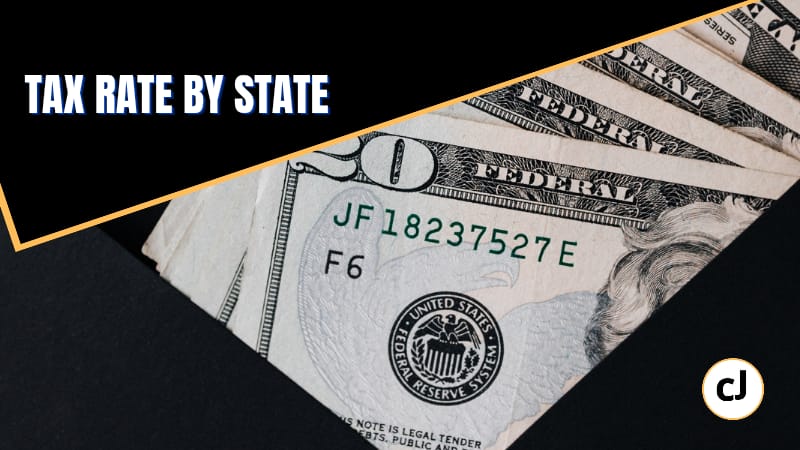Do you know what your state’s tax rate is? How about the tax rate of other states? You may be amazed that some states have a higher tax rate than others. Here we will share with you the tax rate by state.
US citizens pay tax at two levels- federal and state. Everyone already knows about the federal income tax levied on the citizens. After all, filling out the tax returns and getting refunds is a long-drawn-out process. But what about state tax? The US states also collect income, sales, and property tax.
However, unlike the federal income tax rates, the states don’t have a common procedure for collecting taxes. Each US state has a tax structure and procedure to impose taxes on its citizens. Some states don’t collect income tax, while a few states have the highest income tax rate.
So how do you know about the tax rates in the states? How does the tax rate affect the cost of living in the state? Let’s find out.
Quick Navigation
State Income Tax

All taxes are a burden on your wallet, and there isn’t much you can do about it. Being informed about the tax rates, structure, etc., can help you manage your finances effectively. State income tax is the tax imposed on your income by the US state you reside in.
The tax collected by the states is used to fund the state budget. Incomes from governmental schemes and payouts (Social Security, medical, etc.) are not usually taxed by the states. After all, these are considered the obligations of the state.
Many states also have some sort of standard deduction or itemized deduction where you can reduce the taxable income (since you already pay federal tax on the amount). State income tax is broadly classified into the following:
- States with no income tax (these states either offer fewer services or tax the citizens in other forms. Incidentally, such taxes might also have a higher cost of living).
- States with flat tax rates (these states have a fixed tax structure for every citizen. They either impose a tax on all income or collect tax only on interests/ dividends, but at the same tax rate).
- States with progressive tax rates (these states have a detailed income tax structure where people with higher income pay more tax).
State Property Tax
Property tax is the tax amount a property owner pays to the government. The property tax rates are calculated annually and tend to change often. All US states levy property tax with no exceptions. States like Hawaii, Alabama, Colorado, and Louisiana have the lowest property tax rates (less than 1%).
States like New Jersey and Illinois are the opposite, with the highest property rates. New Hampshire follows Illinois with a property tax rate of 2.20%.
State Sales Tax

State sales tax is the tax amount imposed on the sale of certain products and services sold in the state. Similar to property tax, all US states have sales tax to fund their budgets. The average sales tax falls between 4% and 7%, though states like Alaska, New Hampshire, Oregon, Montana, and Delaware have 0% sales tax.
California has the highest sales tax at 7.25%, plus a local sales tax of 1.31%. The same goes for Tennessee, with state sales tax at 7% and local sales tax at 2.47%. Then, there’s a use tax for products you buy in other states but use in the state you reside in.
States with No Income Tax
Eight states in the US don’t levy income tax on their citizens- Alaska, South Dakota, Florida, Texas, Nevada, Wyoming, Tennessee, and Washington. New Hampshire has a flat rate of 5% tax on dividends and interests.
While such states seem like great places to live, the reality is a bit different. The property tax, sales tax, and other state taxes are higher to compensate for the lack of income tax. You might just end up paying even more if you don’t understand how it works.
Alaska
In Alaska, there is no income tax and no sales tax, and it has an average tax rate of 5.14% (including sales, income, property, excise, etc.). However, the state ranks at 47/50 in terms of affordability. Though the remote location is one reason for the increase in the cost of living, the lowest state tax rate is another important reason.
Nevada
The total tax burden in Nevada is 8.23%. Just about everything is taxed in this state except for your income. Even the affordability ranking is 41/50, which makes Nevada a tough place for residents. Of course, tourism is a major attraction, thanks to Las Vegas.
Florida
Florida has a total tax burden of 6.97% and is a favorite place for retirees and tourists. Even though the sales and excise tax of the state are on the higher side, the lack of income tax brings the average down. Florida ranks at 31/50 for affordability. Not exactly an easy place to live, isn’t it?
Texas
Texas has a total tax burden of 8.19% but ranks at 22/50 in terms of affordability. The state doesn’t collect income tax but earns its budget from the property, sales, and excise tax. The sales and property taxes are rather high in some jurisdictions in Texas.
Washington
Washington has the highest total state tax burden at 8.34% in the list of states with no income tax. The state is also expensive to live in, with a 44/50 rank for affordability. The cost of living and housing is more than the average, yet Washington is ranked as the best state for living in, according to the US News & World Report.
South Dakota
South Dakota falls in the middle of things with a tax burden of 7.37% and an affordability ranking of 14/50. The sales tax is the highest in this state, followed by property tax. Of course, the state isn’t known for its infrastructure facilities, which need considerable improvement.
Tennessee
Tennessee is the second best state (in the no income tax states list) with an affordability ranking of 17/50. The total state tax burden is 5.74% happens to be the second lowest in the country. The state plans to attract retirees with investment income as residents.
Wyoming
Wyoming has a total tax burden of 6.14%, which is the third lowest in the country. Individuals and corporations are not subject to income taxes, and even the sales tax is comparatively less. It has an affordability rank of 33/50.
New Hampshire

New Hampshire taxes indirect income like interests and dividends. The total state tax burden comes to 6.84% of the income. The state ranks at 38/50 for affordability. It has sales and excise tax and a plan to phase out investment tax over five years at 1% per year. This will reach the final implementation by 2027.
States with Flat Income Tax Rate
The following US states have a flat tax rate on income. That said, what the state considers income changes from one to another.
- Pennsylvania has the lowest flat tax rate at 3.07%
- North Carolina has the highest flat rate (but not overall highest) at 5.25%
- Kentucky and Massachusetts have the second-highest flat rate of 5%
- Utah and Illinois levy a 4.95% flat tax rate on income
- There is a flat tax rate of 4.55% in Colorado
- Michigan has 4.25%, and Indiana has 3.23%
States with Highest Tax Rate
It’s now time to check out the states with the highest income tax imposed on the citizens.
- California tops the list with 13.3% personal state income tax
- Wisconsin is at the bottom of the list with a 7.65% state income tax
- Hawaii has 11% closely followed by New Jersey with 10.75%
- Oregon comes next with 9.9% state income tax, with Minnesota right behind at 9.85%
- District of Columbia imposes a state income tax of 8.95%
- New York has an 8.82% tax rate, while Vermont has 8.75%, and Iowa has 8.53%
- Arizona has an 8% state income tax rate
State-Wise Tax Rates in the US

| State | State Tax Rate |
| Ohio | 0%-4.797% |
| Delaware | 0%-6.6% |
| South Carolina | 0%-7% |
| Iowa | 0.33%-8.53% |
| Oklahoma | 0.5%-5% |
| California | 1%-13.3% |
| Georgia | 1%-5.75% |
| Montana | 1%-6.9% |
| North Dakota | 1.1%-2.9% |
| Idaho | 1.125%-6.925% |
| New Jersey | 1.4%-10.75% |
| Hawaii | 1.4%-11% |
| Missouri | 1.5%-5.4% |
| New Mexico | 1.7%-5.9% |
| Alabama | 2%-5% |
| Maryland | 2%-5.75% |
| Virginia | 2%-5.75% |
| Louisiana | 2%-6% |
| Arkansas | 2.0%-5.9% |
| Nebraska | 2.46%-6.84% |
| Arizona | 2.59%-8% |
| Mississippi | 3%-5% |
| West Virginia | 3%-6.5% |
| Connecticut | 3%-6.99% |
| Kansas | 3.1%-5.7% |
| Vermont | 3.35%-8.75% |
| Wisconsin | 3.54%-7.65% |
| Rhode Island | 3.75%-5.99% |
| New York | 4%-8.82% |
| District of Columbia | 4%-8.95% |
| Oregon | 4.75%-9.9% |
| Minnesota | 5.35%-9.85% |
| Maine | 5.8%-7.15% |
Final Words
We hope you have the necessary information to understand the living conditions in different states to manage your finances.
Figuring out the tax rate for each state can be tricky but provides you a basic idea of the cost of living in the place. Of course, you need to consider several other factors to determine the best US state for your requirements.

